|
|
|
Sort Order |
|
|
|
Items / Page
|
|
|
|
|
|
|
| Srl | Item |
| 1 |
ID:
138215
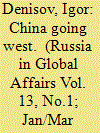

|
|
|
|
|
| Summary/Abstract |
Plans to create a Silk Road Economic Belt, which Chinese President Xi Jinping unveiled in a speech at the Nazarbayev University on September 7, 2013, at first sight looked nothing but a beautiful historical allusion, a nice figure of speech that had dawned upon official speech-writers or Foreign Ministry officials responsible for preparing Xi's trip to Central Asia.
|
|
|
|
|
|
|
|
|
|
|
|
|
|
|
|
| 2 |
ID:
147106
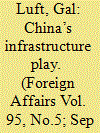

|
|
|
|
|
| Summary/Abstract |
Over the past three millennia, China has made three attempts to project its economic power westward. The first began in the second century BC, during the Han dynasty, when China’s imperial rulers developed the ancient Silk Road to trade with the far-off residents of Central Asia and the Mediterranean basin; the fall of the Mongol empire and the rise of European maritime trading eventually rendered that route obsolete. In the fifteenth century AD, the maritime expeditions of Admiral Zheng He [1] connected Ming-dynasty China [2] to the littoral states of the Indian Ocean. But China’s rulers recalled Zheng’s fleet less than three decades after it set out, and for the rest of imperial history, they devoted most of their attention to China’s neighbors to the east and south.
|
|
|
|
|
|
|
|
|
|
|
|
|
|
|
|
| 3 |
ID:
139347
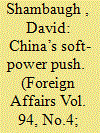

|
|
|
|
|
| Summary/Abstract |
As China’s global power grows, Beijing is learning that its image matters. For all its economic and military might, the country suffers from a severe shortage of soft power. According to global public opinion surveys, it enjoys a decidedly mixed international image. While China’s economic prowess impresses much of the world, its repressive political system and mercantilist business practices tarnish its reputation. And so, in an attempt to improve perceptions, Beijing has mounted a major public relations offensive in recent years, investing billions of dollars around the world in a variety of efforts.
|
|
|
|
|
|
|
|
|
|
|
|
|
|
|
|
| 4 |
ID:
164058
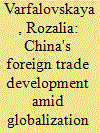

|
|
|
|
|
| Summary/Abstract |
According to China's customs statistics, its foreign trade grew from 2010 to 2017 by 1.4 times (from $2,974 billion to $4,105 billion). The countries situated along the of the Silk Road Economic Belt (SREB) and the Maritime Silk Road of the 21st Century (MSR-21) now account for over a quarter of its foreign trade turnover.
|
|
|
|
|
|
|
|
|
|
|
|
|
|
|
|
| 5 |
ID:
146282
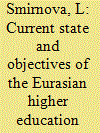

|
|
|
|
|
| Summary/Abstract |
RUSSIA'S EASTWARD TURN in its foreign policy has resulted in the resumption of debates on proposed Eurasian priorities in its educational and scientific policies. The political basis for this is a Russian-Chinese statement on the planned mutual integration of two projects, the Eurasian Economic Union and Silk Road Economic Belt, that was issued during a Russian-Chinese summit in Moscow on May 8, 2015.
|
|
|
|
|
|
|
|
|
|
|
|
|
|
|
|
| 6 |
ID:
140750
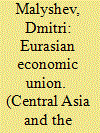

|
|
|
|
|
| Summary/Abstract |
The integration unions that have emerged in the post-Soviet region can guarantee its states preservation of their sovereignty, as well as the opportunity to oppose various internal and external threats, challenges, and risks. Kazakhstan and Russia have become the driving forces behind the integration processes in post-Soviet Eurasia, and these two countries bear the responsibility for maintaining stability in the region.
|
|
|
|
|
|
|
|
|
|
|
|
|
|
|
|
| 7 |
ID:
137328
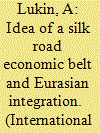

|
|
|
|
|
| Summary/Abstract |
IN A SPEECH at Nazarbayev University in Astana on September 7, 2013. President Xi Jinping of the People's Republic of China (PRC) proposed the idea of building an economic belt along the Silk Road as a new form of enhancing cooperation between China, the Central Asian states and Russia. Various aspects of this idea have become a topic of heated debate in China and other countries. In order to identify the new elements of this concept and understand its role in the contest of ideas and projects associated with Central Asia, we must take a brief look at the history of this issue.
|
|
|
|
|
|
|
|
|
|
|
|
|
|
|
|
| 8 |
ID:
157599
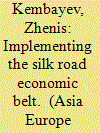

|
|
|
|
|
| Summary/Abstract |
The concept of the Silk Road Economic Belt put forward by the Chinese President Xi Jinping in September 2013 has two major dimensions: “the Road” and “the Belt”. This article examines the background, the legal status, values, institutional framework and major areas of cooperation of the Shanghai Cooperation Organisation (SCO). In doing so, it argues that building “the Road” may lead to the following: (a) the transformation of the SCO from hitherto primarily security-oriented alliance into “the Belt”, i.e. an organisation pursuing also deep economic cooperation, and (b) the establishment of a Silk Road Union based on partnership between SCO and the Eurasian alliance, constituted by two most important regional integration groupings created in the post-Soviet area, the Collective Security Treaty Organization and the Eurasian Economic Union.
|
|
|
|
|
|
|
|
|
|
|
|
|
|
|
|
| 9 |
ID:
147740
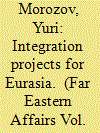

|
|
|
|
|
| Summary/Abstract |
China has proposed a number of integration concepts that are compatible with the interests of Russia but contradict efforts by the United States to maintain a unipolar world order under its hegemony. The author's aim is to assess the pluses and minuses of RF and PRC integration projects in Eurasia, identify the obstacles standing in the way of their execution, and find ways of eliminating existing problems.
|
|
|
|
|
|
|
|
|
|
|
|
|
|
|
|
| 10 |
ID:
155242
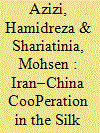

|
|
|
|
|
| Summary/Abstract |
Iran served as a bridge in the ancient Silk Road, connecting the East and the West. It also has great potential to play an important role in the new Silk Road. The present study analyzes the factors affecting Iran–China cooperation in the context of the Belt and Road Initiative at the strategic and operational levels. This article shows that, at the strategic level, Iran defines this project as an opportunity to improve its status in the world economy, expanding its room to manoeuvre in the international arena and developing its ties with China, a rising great power. At the operational level, the opportunities and challenges for Iran–China cooperation could be summarized as pertaining to five realms within the Silk Road Economic Belt Initiative: policy coordination, facilitation of connectivity, unimpeded trade, financial integration and people-to-people bonds. The present study asserts that the main opportunity for cooperation between the two countries lies in facilitating connectivity and that the key challenge is financial integration.
|
|
|
|
|
|
|
|
|
|
|
|
|
|
|
|
| 11 |
ID:
154632
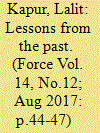

|
|
|
| 12 |
ID:
183440
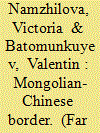

|
|
|
|
|
| Summary/Abstract |
This article deals with specific features in the development of frontier infrastructure on the Mongolian-Chinese border. Noting the fast development of foreign trade relations between Mongolia and China, the authors examine changes taking place in the frontier area. They focus on the current system of checkpoints and also on the prospects for opening new border crossings, in connection primarily with the export of mineral resources.
The research was carried out under the direction of the Buryat Scientific Center of the RAS SB and the Baikal Institute of Nature Management of the RAS SB.
|
|
|
|
|
|
|
|
|
|
|
|
|
|
|
|
| 13 |
ID:
164053
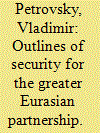

|
|
|
|
|
| Summary/Abstract |
The article considers theoretical and practical aspects of ensuring regional security in establishing the Greater Eurasian Partnership. Since it is being created on the basis of the Eurasian Economic Union and the Chinese One Belt, One Road (OBOR) initiative, existing mechanisms of security in Eurasia, including the Shanghai Cooperation Organization, and possibly private security and military services providers, could be used to ensure security for these projects. ... Keywords: Greater Eurasian Partnership, Shanghai Cooperation Organization, regional security, Eurasian Economic Union, Silk Road Economic Belt, private security and military services providers. Could be used to ensure security for these projects.
|
|
|
|
|
|
|
|
|
|
|
|
|
|
|
|
| 14 |
ID:
149568
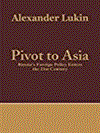

|
|
|
|
|
| Publication |
New Delhi, Vij Books India Pvt Ltd, 2017.
|
| Description |
viii, 430p.hbk
|
| Standard Number |
9789385563645
|
|
|
|
|
|
|
|
|
|
|
|
Copies: C:1/I:0,R:0,Q:0
Circulation
| Accession# | Call# | Current Location | Status | Policy | Location |
| 058920 | 327.47/LUK 058920 | Main | On Shelf | General | |
|
|
|
|
| 15 |
ID:
151263
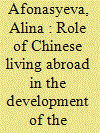

|
|
|
|
|
| Summary/Abstract |
The author examines the economic influence of Chinese living abroad on the main regions of China, Kazakhstan, and Russia through which the Northern Branch of the Silk Road Economic Belt is supposed to be forged. She analyzes the territorial structure of investments and the branch structure of huaqiao enterprises in the economic region of the Bohai Bay ring and individual settlements of the central and western regions of China. She also examines the branch structure of big Chinese state-owned and private companies in Kazakhstan and Russia , as well as opportunities for business communities of Chinese living in foreign countries to participate in the development of the project.
|
|
|
|
|
|
|
|
|
|
|
|
|
|
|
|
| 16 |
ID:
155243
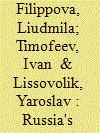

|
|
|
|
|
| Summary/Abstract |
The article aims to highlight Russian approaches to Chinese One Belt-One Road initiative. It examines possible opportunities and challenges for co-development of the Eurasian Economic Union and the Belt project. Both projects and their co-development may reduce the uncertainty in Eurasia, caused by significant structural changes in international relations and the world economy, the emergence of new trade regimes and the erosion of leadership in international affairs. Russian interests in this regard are determined by the need for modernization and long-term development, which could also help to address acute security issues. These particular factors encouraged Russia to come up with an ambitious plan of the Extensive Eurasian Partnership, although the prospects of its implementation currently are uncertain. The present article argues that the success of Russia-China collaboration in Eurasia will depend crucially on the future dynamics of the Eurasian integration, as well as on the agreement to co-develop the Eurasian Economic Union and the Belt Initiative with concrete and mutually beneficial projects.
|
|
|
|
|
|
|
|
|
|
|
|
|
|
|
|
| 17 |
ID:
160718
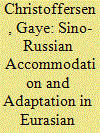

|
|
|
|
|
| Summary/Abstract |
Chinese and Russian officials and scholars discursively construct and reconstruct repeatedly the nature and boundaries of Eurasian regional integration in an ongoing process of regional order construction guided by diverging concepts that involve the Eurasian Economic Union, the Silk Road Economic Belt, and the Greater Eurasian Partnership. There is a process of accommodation and adaptation that has led to a slow unfolding of a Eurasian regional order. I draw on the English School to examine Sino-Russian efforts to maintain a Eurasian regional order rather than to slip into an unbridled rivalry for spheres of influence.
|
|
|
|
|
|
|
|
|
|
|
|
|
|
|
|
|
|
|
|
|